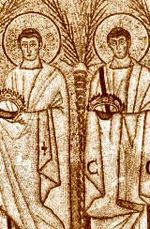
Summary
Saints Protus and Hyacinth were Christian martyrs during the persecution of Emperor Valerian (257–259 AD). Protus' name is sometimes spelled Protatius, Proteus, Prothus, Prote, and Proto. His name was corrupted in England as Saint Pratt. Hyacinth is sometimes called by his Latin name Hyacinthus (in French: Hyacinthe; Spanish: Jacinto; and Italian: Giacinto).
Saints Protus and Hyacinth | |
|---|---|
 Saints Protus and Hyacinth | |
| Martyrs | |
| Born | 3rd century |
| Died | c. 257–9 Rome |
| Venerated in | Catholic Church, Coptic Orthodox Church and Eastern Orthodox Church |
| Major shrine | San Giovanni dei Fiorentini, as well as the chapel of the Propaganda College. Both in Rome. |
| Feast | September 11 (Roman Catholic Church), December 24 (Byzantine Catholic and Eastern Orthodox Churches)[1] |
| Attributes | Depicted as two young men, holding the crowns of martyrdom |
The day of their annual commemoration is mentioned in the "Depositio Martyrum" on September 11, in the chronographia for the year 354.[2] The chronographia also mentions their graves, in the Coemeterium of Basilla on the Via Salaria, later the Catacomb of St. Hermes. The "Itineraries" and other early authorities likewise give this as their place of burial.[3]
Tradition edit
Tradition holds that Protus and Hyacinth were brothers.[4] They served as chamberlains to Saint Eugenia, and were baptized along with her by Helenus, Bishop of Heliopolis. Devoting themselves zealously to the study of sacred scripture, they lived with the hermits of Egypt and later accompanied Eugenia to Rome. There, they were arrested for their Christianity by Emperor Gallienus (260–268). Refusing to deny their faith, they were first scourged and then beheaded on September 11.
The Graves of Sts. Protus and Hyacinth edit
In 1845, Father Marchi discovered the still undisturbed grave of St. Hyacinth in a crypt of the above-mentioned catacomb. It was a small square niche in which lay the ashes and pieces of burned bone wrapped in the remains of costly stuffs.[5] Evidently the saint had been burnt; most martyrs had suffered death by fire. The niche was closed by a marble slab similar to that used to close a loculus, and bearing the original Latin inscription that confirmed the date in the old Roman Martyrology:
D P III IDUS SEPTEBR
YACINTHUS
MARTYR
(Buried on 11 September Hyacinthus Martyr).
In the same chamber were found fragments of an architrave belonging to some later decoration, with the words:
. . . S E P U L C R U M P R O T I M(artyris) . . .
(Grave of the Martyr Protus)
Thus, both martyrs were buried in the same crypt. Pope Damasus I wrote an epitaph in honor of the two martyrs, part of which still exists.[6] In the epitaph, Pope Damasus calls Protus and Hyacinth "brothers." When Pope Leo IV (847–855) transferred the bones of many Roman martyrs to the churches of Rome, the relics of these two saints were to be translated also; but, probably on account of the devastation of the burial chamber, only the grave of St. Protus was found. His bones were transferred to San Salvatore on the Palatine Hill. The remains of St Hyacinth were placed (June 1933) in the chapel of the Propaganda College. Later, the tombs of the two saints and a stairway built at the end of the fourth century were discovered and restored.
Cult in England edit
St Protus and St Hyacinth's Church, Blisland in Cornwall was dedicated to Saint Protus. It is known locally as St Pratts.
Notes edit
- ^ Saints, December 24, Justin Popović (in Serbian)
- ^ Thierry Ruinart, "Acta martyrum", ed. Ratisbon, 632
- ^ De Rossi, "Roma sotterranea", I, 176–177
- ^ Mike Salter (April 1999). The Old Parish Churches of Cornwall. Folly Publications. p. 12. ISBN 1871731372.
- ^ Marchi, "Monumenti primitivi: I, Architettura della Roma sotterranea cristiana", Rome, 1844, 238 sqq., 264 sqq.
- ^ Ihm, "Damasi epigrammata", 52, 49
References edit
- This article incorporates text from a publication now in the public domain: Herbermann, Charles, ed. (1913). "Sts. Protus and Hyacinth". Catholic Encyclopedia. New York: Robert Appleton Company.
External links edit
- "SS. Protus and Hyacinthus, Martyrs", Butler's Lives of the Saints
- Catholic Encyclopedia: Sts. Protus and Hyacinth
- Catholic Culture: Sts. Protus and Hyacinth
- About Blisland in North Cornwall (refers to a church dedicated to these two saints)
- Santi Proto e Giacinto di Roma (in Italian)


